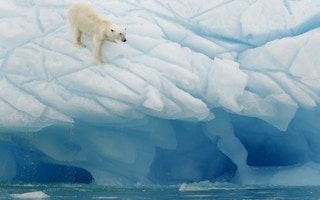The Arctic will stay frozen – for a few years at least. Sea ice, which even in winter has been in retreat for decades, will remain more or less steady in the immediate future, according to new research.
The finding does not mean that global warming has abated, in the polar regions or anywhere else. But a natural cycle of change in the North Atlantic may for the time being have countered the consequences of human combustion of fossil fuels, the rise of greenhouse gases and other impacts in the Arctic.
And the real news is not that the floes will not go just yet, but that scientists can say so with confidence. That is because scientists have fashioned a new technique that makes more accurate prediction possible.
Pattern of change
Stephen Yeager and fellow research scientists in the climate and global dynamics laboratory of the National Centre for Atmospheric Research in Boulder, US, report in Geophysical Research Letters that they checked their simulations by trying to model the pattern of change in the Arctic winter sea ice between 1997 and 2007.
Their “hindcast” matched reality well enough to make them think they could forecast the pattern of the next few years. And slow changes in the North Atlantic circulation will keep the Arctic frozen for just a little longer.
“We know that over the long term, winter sea ice will continue to retreat,” Dr Yeager says. “But we are predicting that the rate will taper off for several years in the future before resuming.
“We are not implying some kind of recovery from the effects of human-caused global warming; it’s really just a slowdown in winter sea ice loss.”
The Arctic Ocean is one of the fastest-warming regions on Earth, and is steadily in retreat. Great tracts melt every summer, and climatologists have predicted that by the close of the century, it could be largely clear blue water by early autumn.
But winter ice remains important, and Arctic governments and communities – and climate modellers and meteorologists – still need reliable, year-on-year information to allow them to see a few years, or even a few decades ahead.
Warm water
This so-called “decadal prediction” exploits knowledge of the great, slow systems that introduce natural variability in regional climates, and one of these is known to oceanographers as the Atlantic meridional overturning circulation (AMOC).
This is the flow of warm water to the far north, which then dives to the sea bottom and returns to the south.
The overturning varies in strength, but its effects are formidable and can sometimes overwhelm human impacts. So if scientists can decipher the indicators delivered by AMOC, they can make an informed guess about the winter ice.
“The sea ice record is so short that it’s difficult to use statistics alone to build confidence in our predictions,” Dr Yeager says.
“Much of our confidence stems from the fact that our model does well at predicting slow changes in ocean heat transport and sea surface temperature in the sub-polar North Atlantic, and these appear to impact the rate of sea ice loss.
“So, we think that we understand the mechanisms underpinning our sea ice prediction skill.”

















